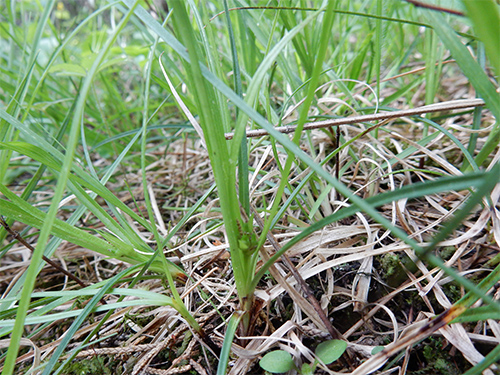Juniper Sedge

Species information
The following is a report on progress made towards the protection and recovery of Juniper Sedge (Carex juniperorum) in Ontario from 2007 to 2020, based on Ontario’s species-specific recovery policy. This report meets the legislative requirement for a review of progress under the Endangered Species Act, 2007 (ESA or “the Act”). Juniper Sedge is listed as endangered on the Species at Risk in Ontario (SARO) List under the ESA.
Juniper Sedge has been classified as a species at risk since 1998. It was originally classified as an endangered species and was listed as such under the ESA when it came into force in June 2008.
Juniper Sedge has been protected from being killed, harmed, harassed, captured or taken since 2003.
In addition, the habitat of Juniper Sedge has been protected from being damaged or destroyed since 2008.
The species-specific recovery policy for Juniper Sedge, known as the Government Response Statement (GRS) was published in 2016 and includes the government’s recovery goal for the species and the actions and priorities it intends to lead or support to help achieve that goal. The GRS considers science advice provided in the recovery strategy, when developing recovery actions for the species. As legislated in the Act, the purpose of this review is to report on progress made towards implementing the protection and recovery actions in the GRS. The review can also help identify opportunities to adjust and adapt the implementation of protection and recovery actions to achieve the recovery goal for the species.
Further information about Juniper Sedge, including the threats that it faces, and actions being taken to help protect and recover this species is available on the Government of Ontario webpage for Juniper Sedge. A summary on the progress towards the protection and recovery of Juniper Sedge and an annual update on the broader species at risk program (i.e. the Introduction to the 2021 Review of Progress report) is available on the Review of Progress towards the Protection and Recovery of Ontario’s Species at Risk webpage.
Snapshot: Progress towards the protection and recovery of Juniper Sedge
Progress towards meeting the recovery goal
- The recovery goal in the Government Response Statement (GRS) for Juniper Sedge in Ontario is to “maintain the current population levels across the species' distribution in Ontario and support natural increases to improve long-term persistence”.
- Progress has been made towards implementing all of the government-led actions. Progress has been made towards implementing all of the government-supported recovery objectives and a majority of the associated actions. Examples of progress include:
- surveys for Juniper Sedge in suitable alvar habitat
- monitoring of existing Juniper Sedge populations
- public education and outreach on Juniper Sedge and threats to protecting and recovering this species
- In alignment with the GRS, more work is needed to manage and secure Juniper Sedge habitat, identify Juniper Sedge life history characteristics and responses to management actions, and study the feasibility and necessity of conserving Juniper Sedge seeds. Some work is also needed to standardize Juniper Sedge surveys and conduct surveys in upland oak forest habitat.
Occurrences and distribution
- Eighty-six records of Juniper Sedge were submitted to the Natural Heritage Information Centre (NHIC) between 1989 to 2018, covering an 11 square kilometre area, mainly from two locations in eastern and southwestern Ontario. More recent records (post-2008) have been made within a 3 square kilometre area across two locations: the Salmon River Area of Natural and Scientific Interest (ANSI) of the Napanee Plain in eastern Ontario and Selkirk Provincial Park in southwestern Ontario. New records of the species have recently been found in two square kilometres within this area, and records from the remaining area reconfirmed, likely the result of increased search effort and knowledge of the species.
Government-supported stewardship projects
- Through the Species at Risk Stewardship Program, the Government of Ontario has enabled its stewardship partners to conduct four projects that have supported the protection and recovery of Juniper Sedge (by providing $85,619 in funding). One project focused exclusively on Juniper Sedge, while the other three projects focused on multiple species at risk, including Juniper Sedge.
- The government’s support helped its stewardship partners to involve 39 individuals who volunteered 415 hours of their time towards protection and recovery activities for species at risk, including Juniper Sedge. The estimated value of these voluntary contributions, as well as additional funding and in-kind support, is $96,674.
- Stewardship partners reported providing outreach on multiple species at risk, including Juniper Sedge, to 2,182 individuals.
- Through the Species at Risk Research Fund for Ontario, the Government of Ontario supported one partner to conduct research on detection methods for cryptic species at risk plants.
Supporting human activities while ensuring appropriate support for species recovery
- No permits, agreements, or registrations have been issued for Juniper Sedge.
Reporting on the progress towards the protection and recovery of Juniper Sedge
Recovery goal
The government’s goal for the recovery of Juniper Sedge is to maintain the current population levels across the species' distribution in Ontario and support natural increases to improve long-term persistence.
The implementation of government-led and government-supported actions demonstrates progress towards reaching the desired objectives and the recovery goal set out in the GRS.
Progress towards implementing government-led actions
Progress has been made towards implementing all government-led actions identified in the GRS. Common actions for the government to lead as it works towards achieving a species’ recovery goal include:
- Educate other agencies and authorities involved in planning and environmental assessment processes on the protection requirements under the ESA.
- Encourage the submission of Juniper Sedge data to the Government of Ontario's central repository at the Natural Heritage Information Centre.
- Undertake communications and outreach to increase public awareness of species at risk in Ontario.
- Protect the Juniper Sedge and its habitat through the ESA.
- Develop direction to provide greater clarity to proponents and partners on the areas of general habitat protected under the ESA for plant species at risk.
- Support conservation, agency, municipal and industry partners, and Indigenous communities and organizations to undertake activities to protect and recover the Juniper Sedge. Support will be provided where appropriate through funding, agreements, permits (including conditions) and/or advisory services.
- Encourage collaboration, and establish and communicate annual priority actions for government support in order to reduce duplication of efforts.
Additionally, the government has directly undertaken the following species-specific actions:
- Continue to manage the habitat of Juniper Sedge in provincially protected areas to maintain the ecological integrity of its habitat and to minimize the threat of recreational pressures and impacts.
- Work with local landowners and land managers to continue to implement the Ontario Invasive Species Strategic Plan to address the invasive species (e.g. Common Buckthorn) that threaten Juniper Sedge.
Key progress made towards implementing these actions is described in the following sections.
Four Juniper Sedge populations are found within the Salmon River Alvar Area of Natural and Scientific Interest (ANSI) in southeastern Ontario, and one population is found at Selkirk Provincial Park in southwestern Ontario. In addition to protection afforded to species at risk under the ESA, several other provincial policies, such as the Planning Act (1990), Provincial Parks and Conservation Reserves Act (2006) and Provincial Policy Statement (2020) protect habitat and species in ANSIs and provincial parks. In addition, Selkirk Provincial Park is monitoring the Juniper Sedge population to inform management actions.
Building on the policy Categorizing and Protecting Habitat under the Endangered Species Act, the government has initiated work to develop general habitat direction for Juniper Sedge and other plant species at risk. Such direction will provide greater clarity to proponents and partners on the areas to be considered habitat for these species and afforded protection under the ESA.
Ontario’s Invasive Species Strategic Plan
The GRS for Juniper Sedge indicates that invasive species (e.g. Common Buckthorn) pose a threat to the survival and recovery of the species in Ontario. The Ontario Invasive Species Strategic Plan, 2012 and Ontario’s Invasive Species Act, 2015 provide the policy and legislative framework to prevent new invaders from arriving and surviving in Ontario; to slow and where possible reverse the spread of existing invasive species, and to reduce the harmful impacts of existing invasive species, including impacts on species at risk. This framework may support the implementation of actions to reduce the threats from invasive species.
Guides and resources
The Napanee-Prince Edward Plain Alvar Ecosystem Recovery Team developed a “Multi-species Recovery Strategy for the Alvar Ecosystems of the Napanee – Prince Edward Plain in southeastern Ontario” (Crowder, Knack, & Norris, 2013), which helped to inform the development of the Juniper Sedge Recovery Strategy and is a valuable accompaniment to this strategy.
Occurrences and distribution
Juniper Sedge is found in the Salmon River ANSI in southeastern Ontario and Selkirk Provincial Park in southwestern Ontario. For this review of progress, the species’ occurrence information has been assessed at a landscape scale using one by one kilometre grid “squares” to approximate the species’ distribution. The squares were used to estimate where the species has been recently observed (i.e., has been observed within the past 20 years) as well as squares where the species is considered historical.
Using this approach, the species has been recently observed in three squares, and there are eight squares with only historical observations
The NHIC has received 86 records of Juniper Sedge. The records are based on observations between 1989 and 2018. Based on records since 2008, the species’ presence has been identified in two new squares and re-confirmed in one additional square. This enlargement of the species’ estimated distribution is most likely the result of increased search effort and education about Juniper Sedge and represents increased knowledge on the distribution of the species.
Efforts to engage citizen scientists in collecting data for these species have increased since 2012, with an assortment of programs and tools available for observations to be submitted and confirmed.
It is possible that there are observations of Juniper Sedge that have not been submitted to the government. Encouraging the submission of observations of this species is included in the GRS as a government-led action and may be required by an authorization or approval. Submission of species observations increases our knowledge of where they occur and can play an important role in assessing the viability of species populations. Observations may now be submitted to NHIC via the Rare Species of Ontario project in iNaturalist
-
44observations of this species were submitted to the NHIC since 2008
Government-supported stewardship projects
An important government-led action in the GRS for Juniper Sedge is to support partners to undertake activities to protect and recover the species. Through the Species at Risk Stewardship Program the the government has supported four projects ($85,619) designed to contribute to the protection and recovery of Juniper Sedge. One of these projects focused exclusively on the species, while the other three projects focused on multiple species at risk, including Juniper Sedge. The project that focused exclusively on Juniper Sedge conducted surveys for this species on the Mohawks of the Bay of Quinte First Nation Territory, but none were found in this area.
In addition to the government funding, partners focusing exclusively on Juniper Sedge reported they were successful in securing additional funding ($2,185) from other sources, as did partners with projects designed to benefit multiple species at risk, including Juniper Sedge ($94,489). These amounts include in-kind support in the form of time and expertise provided by volunteers.
Stewardship partners reported that provincial funding helped them to secure in-kind support by involving 39 individuals who volunteered 415 hours of their time towards protection and recovery activities for multiple species at risk, including Juniper Sedge, which has an estimated value of $18,529. In addition, stewardship partners reported providing ecosystem-based outreach on multiple species, including Juniper Sedge, to 2,182 individuals.
The government also supports proponents in conducting research that addresses important knowledge gaps for species at risk. Through the Species at Risk Research Fund for Ontario, the government provided funding to a partner to conduct research on detection methods for wind- and insect pollinated plant species at risk that are difficult to locate or identify.
The remainder of this section highlights one project supported through the Species at Risk Stewardship Program as well as the corresponding government-supported recovery actions for the species.
The Canadian Wildlife Federation completed monitoring projects for three plant species at risk, including Juniper Sedge, in 2015 and 2016. Juniper Sedge surveys were conducted in areas with prior Juniper Sedge records at Selkirk Provincial Park in southwestern Ontario and at a private property in the Salmon River ANSI in southeastern Ontario. 118 Juniper Sedge “clumps”
Although researchers made requests to survey other potential and known Juniper Sedge populations on private properties in the Salmon River ANSI, access was not granted to most properties due to concerns that survey results might restrict or limit activities in areas where the species was found.
In addition to population monitoring, researchers described the surrounding habitat at survey sites to better understand Juniper Sedge habitat needs and identify potential threats. For example, encroaching Common Buckthorn was identified as a potential threat on the private property, and one-on-one interactions with landowners provided further insight into potential threats on this property, such as land development. No major threats to Juniper Sedge were identified at Selkirk Provincial Park.
Additional Juniper Sedge surveys were conducted at Demorestville Conservation Area, Deseronto Airport Alvar (on the Mohawks of the Bay of Quinte First Nation Territory), and Massassauga Conservation Area where no prior Juniper Sedge records exist, but where there was potentially suitable alvar habitat for Juniper Sedge. Despite several searches, no Juniper Sedge plants were found in these areas.
This project supports the implementation of government-supported GRS Action No. 3, to develop and implement a standardized monitoring protocol and Action No. 4, to identify additional areas with potential suitable habitat.
Species at Risk Stewardship Program
-
 4
4projects included Juniper Sedge
-
 1
1project for Juniper Sedge exclusively
-
 $85,619
$85,619for projects that included Juniper Sedge
-
 $96,674
$96,674in additional funding and in-kind support
-
 39
39volunteers
-
 415
415volunteer hours
-
 2,182
2,182people received outreach
Supporting human activities while ensuring appropriate support for species recovery
Supporting partners through authorizations and their associated conditions is an important government-led action. To date, no permits, agreements, or registrations have been issued for Juniper Sedge.
Progress towards implementing government-supported actions
Government-supported actions are organized under overarching recovery objectives. Progress has been made towards achieving all government-supported recovery objectives and implementing a majority of the associated actions identified in the GRS for Juniper Sedge.
Objective: Protect and manage the habitat of Juniper Sedge to reduce threats to the species in collaboration with local land owners and community partners.
- Action No. 1 (High Priority) – Manage existing habitat for Juniper Sedge using community and species expertise in the implementation of best management practices. This may include:
- conducting mechanical or targeted chemical removal of native or invasive woody vegetation in Juniper Sedge habitat, including Common Buckthorn
- protecting populations from all-terrain vehicles, overgrazing and dumping of garbage in habitat areas through the use of signage and fencing, as appropriate
- evaluating the effectiveness of habitat management techniques such as grazing treatments, increasing canopy openness, prescribed burns and invasive species control
Under this objective, initial progress has been made towards Action No. 1 through a project supported by the Species at Risk Stewardship Program. This project conducted outreach on several species at risk in the County of Hastings, including Juniper Sedge, which resulted in invitations from land owners to visit two Juniper Sedge sites and provide management advice for this species.
Objective: Increase knowledge of the species ' abundance, distribution, site-specific threats, habitat requirements, life history processes and response to habitat management.
- Action No. 3 (High Priority) – Collaborate with local partners and land owners to develop and implement a standardized monitoring protocol to provide a quantitative baseline for future monitoring of all existing populations. This should include:
- developing a standardized approach to determining presence/absence of the species
- developing a standardized approach to enumerating the number of plants present, and clear direction on how to implement that approach when surveying
- determining an estimate of the population abundance
- monitoring changes in site-specific threats to Juniper Sedge populations
- identification of the vegetation community type at occupied sites
- measurements of water and moisture levels at occupied sites
- Action No. 4 – Identify additional areas with potential suitable habitat for Juniper Sedge and conduct presence/absence surveys in these areas.
Under this objective, progress has been made towards implementing Action No. 3 and Action No. 4.
These actions have been primarily implemented through two projects supported by the Species at Risk Stewardship Program that conducted population monitoring and surveys for Juniper Sedge. Monitoring by the Canadian Wildlife Federation (described above) refined population estimates in two areas, reassessed potential threats, and further described Juniper Sedge habitat features, which supports Action No. 3. Two stewardship partners also conducted Juniper Sedge surveys in suitable alvar habitat on the Mohawks of the Bay of Quinte First Nation Territory, which supports Action No. 4.
In addition to these projects, one project supported by the Species at Risk Research Fund is developing a method to detect cryptic plant species at risk that may support the detection of additional Juniper Sedge populations, which supports Action No. 4. Ontario Parks staff are also monitoring the Juniper Sedge population in Selkirk Provincial Park, which supports Action No. 3. Lastly, stewardship partners and citizen scientists have helped to implement both actions by reporting observations of Juniper Sedge to the NHIC and iNaturalist.
Summary of progress towards meeting the recovery goal
The recovery goal for Juniper Sedge is to maintain the current population levels across the species' distribution in Ontario and support natural increases to improve long-term persistence. Effort made towards the government-led and government-supported actions has helped to make progress towards this goal. For example, surveys have been conducted in areas with suitable habitat and known populations have been recently monitored (i.e. in the last five years).
The provincial record of observations suggests that Juniper Sedge continues to persist in the province within three square kilometers, with a potential range of eleven square kilometres. Two of the three square kilometres have been newly-identified since 2008.
Recommendations
As stated in the GRS, this review of progress can be used to help identify whether adjustments to the implementation of GRS actions are needed, to achieve the protection and recovery of the species. Based on progress to date, the overall direction provided in the GRS for Juniper Sedge, particularly the implementation of actions identified as high priority, should continue to guide protection and recovery of the species. In particular and in alignment with the GRS, it would be valuable to focus efforts on collaborating with private land owners to fully implement high priority actions.
Currently, initial progress has been made towards the action to manage existing habitat (Action No. 1 – High Priority). Recognizing progress that has been made, additional work is also needed to fully implement Action No. 3 (High Priority), by working with private land owners to access all Juniper Sedge populations, and Action No. 4, by conducting surveys in upland oak forests. Surveys in upland oak forests can be further targeted to areas in Haldimand County with clay soils and known populations of Willdenow's Sedge (Carex willdenowii), which may be confused with Juniper Sedge (W. Bakowsky, pers. comm. 2021).
Relative to actions that have received a stronger level of support, the following actions have received less attention and are identified for consideration in future work towards the protection and recovery of the species:
- Action No. 2 – As opportunities arise, work with local land owners and community partners to support the securement of Juniper Sedge habitat through existing land securement and stewardship programs.
- Action No. 5 – Research the species' life history characteristics and response to habitat management activities that will inform the implementation of recovery actions for the species. This may include:
- studying mechanisms of pollination, seed dispersal and conditions for germination
- conducting a population viability analysis
- studying the species' response to changes in hydrology
- Action No. 6 – Study the feasibility and necessity of preserving genetic material from the Ontario populations of Juniper Sedge through seed storage (germplasm) conservation.
Protecting and recovering Juniper Sedge will continue to be a shared responsibility that will require the involvement of many individuals, organizations and communities. Financial support for the implementation of actions may be available through the Species at Risk Stewardship Program. The government can also advise if any authorizations under the ESA or other legislation may be required to undertake a project. By working together, progress can continue to be made towards protecting and recovering Juniper Sedge in Ontario.
References
- Crowder, A., Knack, H., & Norris, T. (2013). A Multispecies Recovery Strategy for the Alvar Ecosystems of the Napanee - Prince Edward Plain in southeastern Ontario. Prepared by the Napanee-Prince Edward Plain Alvar Ecosystem Recovery Team.
Personal communications
- Bakowsky, Wasyl. 2021. Correspondence to the Ministry of the Environment, Conservation and Parks, Species at Risk Recovery Section. Community Ecologist, Natural Heritage Information Centre, Ministry of Northern Development, Mines, Natural Resources and Forestry, Peterborough, Ontario.
Footnotes
- footnote[1] Back to paragraph A population is considered historical if it has not been recorded within the last 20 years. Historical populations may still exist, but updated information is not available.
- footnote[2] Back to paragraph It is likely that some historical observations are the result of restricted access to private property where Juniper Sedge populations may still exist
- footnote[3] Back to paragraph iNaturalist is a citizen science initiative, started in 2008 at the University of California at Berkeley, and an online social network of naturalists, citizen scientists, and biologists who map and share observations of biodiversity from around the world through a smart-phone based app or via the iNaturalist website.
- footnote[4] Back to paragraph A group of several plants growing within five centimetres of one another.